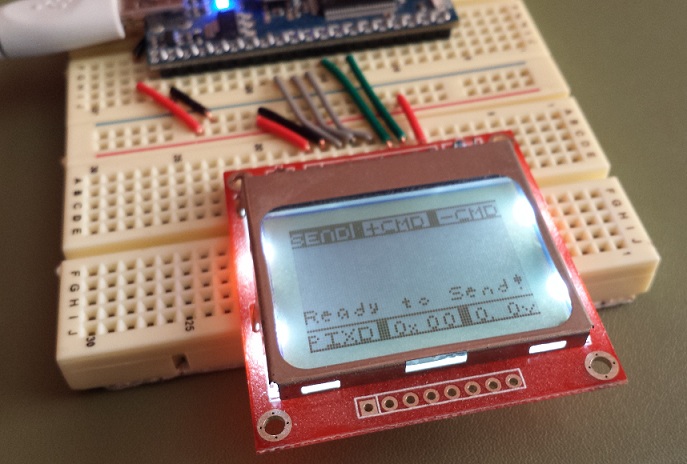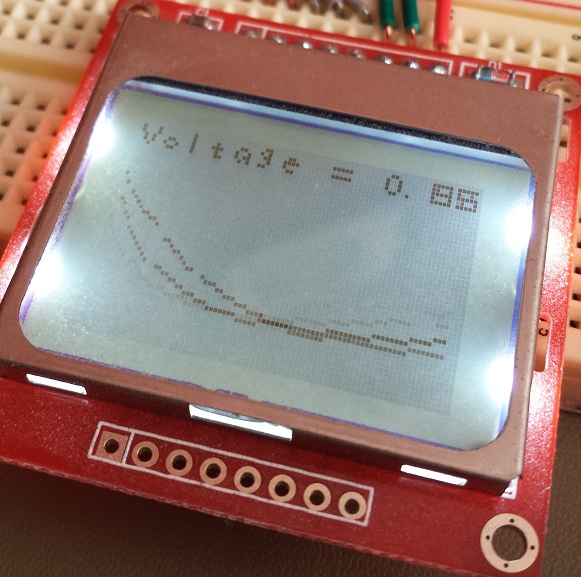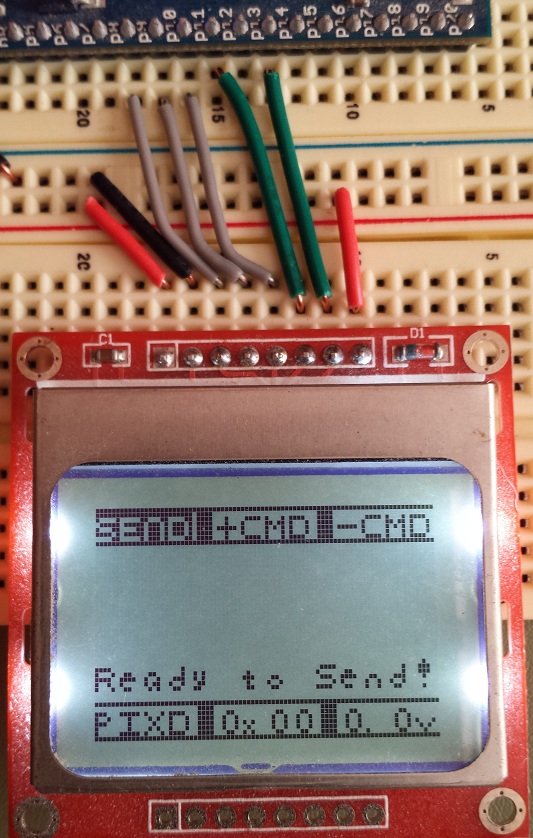A basic LCD output test which uses the NXP LPC1768\'s SPI interface to display pixels, characters, and numbers on the Nokia 5110 or Nokia 3310 LCD.
Quick and versatile LCD screen control. Works as a great alternative to serial consoles!
---------

Inverted-color text function makes easy menus and borders

Uses a simple SetXY(char, char) function to draw data-plots or patterns
- Wiring -

LCD's connections from left to right:
1) +3.3v (V_lcd) - mbed's VOUT
2) GND - mbed's GND
3) SCE (chip select) - mbed's p8
4) RST (reset) - mbed's p9
5) DC (data/command) - mbed's p10
6) MOSI - mbed's p11
7) SCLK (serial clock) - mbed's p13
8) +3.3v (V_backlight) - mbed's VOUT
The code for this setup would be...
LcdPins myPins;
myPins.sce = p8;
myPins.rst = p9;
myPins.dc = p10;
myPins.mosi = p11;
myPins.miso = NC;
myPins.sclk = p13;
or more easily...
LcdPins myPins = { p11, NC, p13, p10, p8, p9 };
Init the NokiaLcd class using the above struct...
NokiaLcd myLcd( myPins );
then start the LCD using...
myLcd.InitLcd();
Simple text output is achieved with either of these functions:
void DrawString(char* str);
void DrawChar(char character);
------
Better documentation, pre/post conditions, and extended draw functions are coming soon :)
Diff: NOKIA_5110.cpp
- Revision:
- 0:fbba596f1039
--- /dev/null Thu Jan 01 00:00:00 1970 +0000
+++ b/NOKIA_5110.cpp Mon Jan 16 19:47:48 2012 +0000
@@ -0,0 +1,128 @@
+// Project: Fuzzy LCD Voltmeter
+// File: NOKIA_5110.cpp
+// Author: Chris Yan
+// Created: January, 2012
+// Revised:
+// Desc: Supporting code for the NokiaLcd class
+
+#include "NOKIA_5110.h"
+#include "mbed.h"
+
+NokiaLcd::NokiaLcd(LcdPins pinout)
+{
+ // SPI
+ LcdSpi = new SPI(pinout.mosi, pinout.miso, pinout.sclk);
+ LcdSpi->format(LCD_SPI_BITS, LCD_SPI_MODE);
+ LcdSpi->frequency(LCD_FREQ);
+
+ // Control Pins
+ Pins = new DigitalOut*[3];
+ Pins[PIN_RST] = new DigitalOut(pinout.rst);
+ Pins[PIN_SCE] = new DigitalOut(pinout.sce);
+ Pins[PIN_DC] = new DigitalOut(pinout.dc);
+
+ // Initial Command Instructions, note the initial command mode
+ FunctionSet.V = CMD_FS_HORIZONTAL_MODE;
+ FunctionSet.H = CMD_FS_EXTENDED_MODE;
+ FunctionSet.PD = CMD_FS_ACTIVE_MODE;
+ FunctionChar = CreateFunctionChar();
+
+ TempControlChar = CMD_TC_TEMP_2;
+ DispControlChar = CMD_DC_NORMAL_MODE;
+ BiasChar = CMD_BI_MUX_48;
+ VopChar = CMD_VOP_7V38;
+}
+
+void NokiaLcd::ShutdownLcd()
+{
+ FunctionSet.PD = CMD_FS_POWER_DOWN_MODE;
+
+ ClearLcdMem();
+ SendFunction( CMD_DC_CLEAR_DISPLAY );
+ SendFunction( CreateFunctionChar() );
+}
+
+void NokiaLcd::ClearLcdMem()
+{
+ Pins[PIN_SCE]->write(0); // Chip Select goes low
+ Pins[PIN_DC]->write(1); // Data/CMD goes high
+
+ for(int tick = 0; tick <= 503; tick++)
+ LcdSpi->write(0x00);
+
+ Pins[PIN_SCE]->write(1); // Chip Select goes high
+}
+
+void NokiaLcd::TestLcd(char test_pattern)
+{
+ Pins[PIN_SCE]->write(0); // Chip Select goes low
+ Pins[PIN_DC]->write(1); // Data/CMD goes high
+
+ for(int tick = 0; tick <= 503; tick++)
+ LcdSpi->write(test_pattern); // Command gets sent
+
+ Pins[PIN_SCE]->write(1); // Chip Select goes high
+}
+
+void NokiaLcd::InitLcd()
+{
+ ResetLcd();
+
+ // Redefine the FunctionChar in case it has changed
+ FunctionSet.V = CMD_FS_HORIZONTAL_MODE;
+ FunctionSet.H = CMD_FS_EXTENDED_MODE;
+ FunctionSet.PD = CMD_FS_ACTIVE_MODE;
+ SendFunction( CreateFunctionChar() ); // Extended CMD set
+ SendFunction( VopChar ); // | Vop
+ SendFunction( TempControlChar ); // | Temp
+ SendFunction( BiasChar ); // | Bias
+
+ FunctionSet.H = CMD_FS_BASIC_MODE;
+ SendFunction( CreateFunctionChar() ); // Basic CMD set
+ SendFunction( DispControlChar ); // | Display Mode
+
+ ClearLcdMem();
+}
+
+void NokiaLcd::ResetLcd()
+{
+ Pins[PIN_RST]->write(0); // Reset goes low
+ Pins[PIN_RST]->write(1); // Reset goes high
+}
+
+char NokiaLcd::CreateFunctionChar()
+{
+ return ( 0x20 | FunctionSet.PD | FunctionSet.V | FunctionSet.H );
+}
+
+void NokiaLcd::SendDrawData(char data)
+{
+ Pins[PIN_SCE]->write(0); // Chip Select goes low
+ Pins[PIN_DC]->write(1); // Data/CMD goes high
+
+ LcdSpi->write(data); // Command gets sent
+
+ Pins[PIN_SCE]->write(1); // Chip Select goes high
+}
+
+void NokiaLcd::DrawChar(char character)
+{
+ for( int i = 0; i < 6; i++)
+ SendDrawData( FONT_6x6[ ((character - 32)*6) + i] );
+}
+
+void NokiaLcd::SendFunction(char cmd) //TODO:Detection of what H should be
+{
+ Pins[PIN_SCE]->write(0); // Chip Select goes low
+ Pins[PIN_DC]->write(0); // Data/CMD goes low
+
+ LcdSpi->write(cmd); // Command gets sent
+
+ Pins[PIN_DC]->write(1); // Data/CMD goes back to Data mode
+ Pins[PIN_SCE]->write(1); // Chip Select goes high
+}
+
+NokiaLcd::~NokiaLcd()
+{
+ ShutdownLcd();
+}
 Krissi Yan
Krissi Yan
 Nokia 5110 / 3310 LCD
Nokia 5110 / 3310 LCD